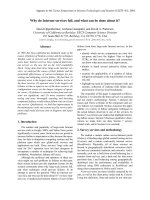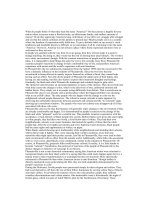Why motivating people doesnt work and what does more breakthroughs for leading energizing and engaging 2nbsped 1523004150 9781523004157
Bạn đang xem bản rút gọn của tài liệu. Xem và tải ngay bản đầy đủ của tài liệu tại đây (8.07 MB, 257 trang )
WHY
MOTIVATING
PEOPLE
DOESN’T
WORK . . .
AND
WHAT DOES
This page intentionally left blank
349-99188_Rothfels_ch01_3P.indd 6
WHY
MOTIVATING
PEOPLE
DOESN’T
WORK . . .
AND
WHAT DOES
More Breakthroughs for Leading,
Energizing, and Engaging
SECOND EDITION
SUSAN FOWLER
Why Motivating People Doesn’t Work…and What
Does, Second Edition
Copyright © 2014, 2017, 2023 by Susan Fowler
All rights reserved. No part of this publication may be reproduced, distributed, or transmitted in any form or
by any means, including photocopying, recording, or other electronic or mechanical methods, without the
prior written permission of the publisher, except in the case of brief quotations embodied in critical reviews
and certain other noncommercial uses permitted by copyright law. For permission requests, write to the
publisher, addressed “Attention: Permissions Coordinator,” at the address below.
Berrett-Koehler Publishers, Inc.
1333 Broadway, Suite 1000
Oakland, CA 94612-1921
Tel: (510) 817-2277, Fax: (510) 817-2278
www.bkconnection.com
Ordering information for print editions
Quantity sales. Special discounts are available on quantity purchases by corporations, associations,
and others. For details, contact the “Special Sales Department” at the Berrett-Koehler address above.
Individual sales. Berrett-Koehler publications are available through most bookstores. They can also be
ordered directly from Berrett-Koehler: Tel: (800) 929-2929; Fax: (802) 864-7626; www.bkconnection.com
Orders for college textbook/course adoption use. Please contact Berrett-Koehler: Tel: (800) 929-2929;
Fax: (802) 864-7626.
Distributed to the U.S. trade and internationally by Penguin Random House Publisher Services.
Berrett-Koehler and the BK logo are registered trademarks of Berrett-Koehler Publishers, Inc.
Second Edition
Library of Congress Cataloging-in-Publication Data
Names: Fowler, Susan, 1951- author.
Title: Why motivating people doesn’t work ... and what does : more
breakthroughs for leading, energizing, and engaging / Susan Fowler.
Description: Second edition. | Oakland, CA : Berrett-Koehler Publishers,
Inc., [2023] | Includes bibliographical references and index.
Identifiers: LCCN 2022049280 (print) | LCCN 2022049281 (ebook) | ISBN
9781523004126 (paperback ; alk. paper) | ISBN 9781523004133 (pdf) | ISBN
9781523004140 (epub) | ISBN 9781523004157 (audio)
Subjects: LCSH: Employee motivation. | Leadership.
Classification: LCC HF5549.5.M63 F69 2023 (print) | LCC HF5549.5.M63
(ebook) | DDC 658.3/14—dc23/eng/20221012
LC record available at />LC ebook record available at />
2023–1
Interior design: Reider Books
Cover design: Frances Baca
Copyediting: PeopleSpeak
For Drea
This page intentionally left blank
349-99188_Rothfels_ch01_3P.indd 6
Contents
Foreword by Garry Ridge
ix
Introduction: Stop Beating Your People with Carrots
1
1. The Motivation Dilemma
11
2. What Motivates People: The Real Story
27
3. Shifting Out of Overdrive
47
4. If Motivating People Doesn’t Work . . .
What Does?
69
5. Rethinking Leadership Now That Everything
Else Has Changed
111
6. Leader, Heal Thyself
161
7. Are Your Beliefs Eroding People’s Optimal
Motivation?179
8. The Promise of Optimal Motivation
199
Afterword by Ken Blanchard
207
Notes209
Bibliography215
Resources227
Acknowledgments231
Index234
About the Author
241
vii
This page intentionally left blank
349-99188_Rothfels_ch01_3P.indd 6
Foreword
by Garry Ridge
W
hen I stepped down as CEO after twenty-five years,
I handed over the secret formula to WD-40’s MultiUse Product to a new era of leadership. During that time, our
water-displacement lubricant in the blue and yellow cans with
the little red top called WD-40 emerged as one of the most
recognizable household items in the world. Warren Buffet
regards it as a brand with one of the best competitive moats
on the planet.1
Most people assume that WD-40’s success is its secret
formula. And they are right. But I believe it’s our other secret
formula that guided us to a market cap that’s grown from $300
million to $2.5 billion and exceeded the performance of the
Russell 2000 and S&P by a long shot, delivering a shareholder
return of 1,369 percent without laying off a single person in
hard economic times or during the COVID-19 pandemic.
What is the other secret formula? WD-40 is fueled by an optimally motivated workforce demonstrated through our people’s
spirit, morale, inspiration, commitment, and desire to use their
discretionary effort on behalf of our company.
ix
x
FOREWORD
It seems impossible that there is anyone left in the world
who still needs convincing that a people-first culture is essential to the long-term success of any company. In the good years
and the not-so-good years, it is the spirit of our people that
makes us great. But we animated our hidden secret by building
an inclusive and diverse, learning and teaching, and purposeful
organization where our people succeed together while excelling as individuals. Some see human capital as an expense. We
see our people, our tribe, as the essence of our organization.
Our success comes from nurturing people’s optimal motivation and engagement.
That’s where Susan’s work comes in. I first met Susan in 2001
when I decided to earn my master of science in executive leadership from the University of San Diego. She and her husband, Dr.
Drea Zigarmi, taught the first week of the twenty-two-month
program. Susan’s research on motivation science was in its early
stages. For the past twenty years, she has refined her approach
and the Spectrum of Motivation® model with thousands of leaders from organizations in over forty countries.
Dozens of WD-40 Company executives have participated in
the master’s program, learning to master motivation for themselves and others. WD-40 Company’s special formula for success aligns with what motivation science proves: the optimal
motivation required for people to thrive and produce quality
results comes from fulfilling people’s three psychological needs.
WD-40 Company’s Special
Formula for Success
Our job as leaders is to make sure we create an environment
where our tribe members wake up each day inspired to go to
FOREWORD
xi
work, feel safe while they are there, and return home at the end
of the day fulfilled by the work that they do, feeling that they
have learned something new and contributed to something
bigger than themselves. At WD-40 Company, we do that in
three ways:
We encourage choice. We promote autonomy by helping
people move from fear to freedom. We eliminated one of
the greatest fears—the fear of failure. People do not fail
at WD-40 Company; they have learning moments. We
define a learning moment as a positive or negative outcome of any situation that needs to be openly and freely
shared among the tribe. We celebrate learning moments.
We deepen connection. I’m convinced that the heart of our
success is built on a culture of belonging. Our culture
reflects a self-sustaining and interdependent tribe where
members share common attributes such as values, knowledge, celebration, ceremony, and a strong sense of belonging. Belonging is not all “kumbaya.” It is a balance between
being tough-minded and tenderhearted—where people
feel safe and able to do their best work.
When other companies were experiencing the Great
Resignation starting in 2020 (I really think it was the
Great Escape from toxic cultures), our employee engagement average remained at 93 percent, including 98 percent reporting excitement about the company’s future. If
we had employee engagement like most companies have,
we would need twice as many people to do the same job,
which means that we would not have the financial results
we have today.
xii
FOREWORD
We build competence. Our company focuses on learning
moments, encouraging tribe members to try something
new, ask for help, and learn from their experiences. But we
also proactively build people’s competence through peer
coaching. Every leader is also a coach, responsible for promoting people’s growth.
We know motivating people doesn’t work, but we’ve figured out what does. I’ve witnessed firsthand how Susan’s work,
captured in this book, teaches you how to create a space where
your tribe members will flourish. It takes dedication to create
that safe playing field where people experience choice by moving from fear to freedom, connection through relationships
protected by values and inspired by vision, and competence
gained from learning moments. But it also takes skill based on
a framework capturing the truth about human motivation and
proven strategies leaders can apply daily so people can be the
next version of their best selves.
Garry Ridge currently serves as chairman emeritus of WD-40 Company
and coaches executives on how to lead a culture focused on people, purpose, passion, and product through his company, the Learning Moment.
INTRODUCTION
Stop Beating Your
People with Carrots
A
funny thing happened on the way to understanding
human motivation. Psychologists decided to study animals. For example, you can watch Harvard psychology professor B. F. Skinner on YouTube showing how he motivates a
conditioned pigeon to do a 360-degree turn by rewarding its
behavior with pellets. It is fascinating to watch as he rewards
the bird for doing what he wants it to do—he can get it to do
almost anything. Behaviorists reasoned that this method could
motivate people in the workplace the same way: reward people
for doing what you want them to do, and you can get them to
do almost anything. And guess what? It worked—or seemed
to. I call it the Pecking Pigeon Paradigm.
Using metaphorical pellets as incentives to motivate people to do tasks they don’t necessarily want to do has become
common practice. A massive industry exists to sell and support
complex schemes for motivating workers with compensation
systems, rewards, contests, tokens, badges, prizes, and formal
recognition programs. Pellets and more pellets.
1
2
W HY MOT IVAT IN G P EOP L E D OESN ’T WO R K
Irrefutable evidence demonstrates the futility of the Pecking Pigeon Paradigm. In thousands of experiments worldwide,
the results are the same: even though people will take the
money or rewards you offer, the only correlation between those
incentives and performance is a negative one. In other words,
external rewards produce a disturbing undermining effect on
the energy, vitality, and sense of positive well-being people
need to achieve goals, attain excellence, and sustain effort.1
Traditional forms of motivation may appear to work in
some types of jobs or industries. For example, if you promise
people more pellets, they may produce more on the assembly line in the short term. However, it is unwise to confuse
productivity with thriving and flourishing. Without thriving and flourishing, short-term gains tend to turn into longterm opportunity losses. The Pecking Pigeon Paradigm never
worked the way we thought it would—no matter the type of
job or industry. The simple fact is, people are not pigeons.
This book offers plenty of proof that motivating people doesn’t work. But the benefit for you—and my primary
focus—is an empirically based and globally field-tested
approach to developing your leadership capacity so you can
take advantage of good science.
We Have Learned How to
Put the Science to Work
Valid scientific and academic research requires four to six
decades to make it into mainstream awareness. In the 1960s,
the early appearances of the Self-Determination Theory
(SDT) proposed by Dr. Edward Deci and Dr. Richard Ryan
Stop B eating Your P eople with C arrots
3
were considered provocative. Now you find nearly universal
support for SDT, thanks to Deci and Ryan’s dedication to a layered and thoughtful methodology, groundbreaking research
supported by thousands of dedicated researchers around the
world, and bestselling books by Alfie Kohn, Daniel Pink, and
yours truly.2 This elegant and complex theory is now firmly
established at the perimeter of mainstream consciousness.3
My aim for the past twenty years has been to understand,
translate, and apply the best motivation science to improve
the quality of our lives, personally and professionally. Oliver
Wendell Holmes allegedly said he didn’t give a fig for the
simplicity that lies on this side of complexity. So I’ve strived
for the simplicity that lies on the other side of complexity.
We’ve come a long way toward gaining that higher level of
simplicity since the original 2014 version of Why Motivating
People Doesn’t Work . . . and What Does became a bestseller and
was translated into fourteen languages.
This second edition benefits from years of application and
feedback, a refinement of language and processes, and new
success stories. I have had the privilege of traveling around the
world refining the Spectrum of Motivation model, testing the
skill of motivation, and developing the three leadership capacities that encourage choice, deepen connection, and build competence. I started Mojo Moments®, a company with dozens of
global partners dedicated to teaching the skill of motivation to
leaders at all levels in the organization. This edition also benefits from recent research revealing what we learned about motivation during the COVID-19 pandemic years.
If you read the original book, you’ll notice a change in
language and the introduction of new terms. For example, the
4
W HY MOT IVAT IN G P EOP L E D OESN ’T WO R K
academic terms for the three basic psychological needs, autonomy, relatedness, and competence (affectionately referred to as
ARC) are now choice, connection, and competence (with the
blessing of Deci and Ryan, by the way).
You Still Need to Ask the Right Question
Are you motivated to read this book? You might find this a
strange question given that you have already read this far. I
agree it is silly but perhaps for a different reason.
Asking if you are motivated raises more questions than
answers. What criteria do you use to determine whether you
are motivated? If I asked you to decide whether a colleague
of yours is motivated to read this book, how would you reach
your conclusion? How do you evaluate another person’s motivation? What does motivation even mean?
For many years, my go-to definition of motivation was
simply “the energy to act.” It turns out my definition has the
same fatal flaw as the other 102 definitions you can find for
motivation.4 Thinking of being motivated as having the energy
or impetus to act fails to convey the essential nature of human
motivation. It does nothing to help you understand the reasons behind the action.
Asking if you are motivated to read this book is simply the
wrong question. What if I asked instead, Why are you motivated to read this book? I might discover that you are reading
this because you take being a leader seriously and you are
struggling with the motivation of a staff member. You are hoping this book might shed light on your motivation dilemma.
Stop B eating Your P eople with C arrots
5
Or I might discover that you are reading it because the head of
your department told you to read it and you’re afraid of what
might happen if you don’t. These two very different reasons for
being motivated generate different qualities of energy. Instead
of asking if you are motivated, I need to ask a different question
to reveal your reasons for acting.
An important truth emerges when you explore the nature
of motivation: people are always motivated. The question is
not if but why they are motivated.
The motivation—or energy and impetus—a person brings
to any action can be qualitatively different. Some reasons people are motivated tend to promote well-being for others and
themselves—and unfortunately, some reasons don’t:
• Motivation that comes from choosing to do something is
different from motivation that comes from having to do
it.
• Motivation generated from values, purpose, love, joy,
or compassion is different from motivation generated
from ego, power, status, or a desire for external rewards.
• Motivation to compete because of a desire to excel
(where the score serves as feedback on how successfully
you are growing, learning, and executing) is different
from the motivation to compete to best someone else,
impress, or gain favors.
One of the primary reasons motivating people doesn’t
work is our naïve assumption that motivation is something
a person has or doesn’t have. This leads to the erroneous
6
W HY MOT IVAT IN G P EOP L E D OESN ’T WO R K
conclusion that the more motivation a person has, the more
likely she will achieve her goals and be successful. When it
comes to motivation, assuming that more is better is too simplistic and even unwise. Motivation is similar to friendship: it
doesn’t matter how many friends you have but rather the quality and types of friendships.5
Imagine you are a sales manager. You wonder if your sales
reps are motivated. You look at the midquarter sales reports for
your two highest-selling reps and conclude, yes, they are both
highly motivated. What you might fail to notice is that they are
motivated differently. The reason one rep works hard is to win
the sales contest, be seen as number one, and make the promised bonus. The reason the other rep works hard is that he values your products and services, his efforts are connected to a
noble purpose, and he enjoys problem-solving with his clients.
The science of motivation provides compelling evidence that
the reps’ different types of motivation have major implications.
The quality of their energy affects short-term results and longterm stamina.6
Traditional motivation prompts the wrong questions: Is
this person motivated? How much motivation does this person have? These questions reduce your answers to simplistic black-and-white, yes-or-no responses that fail to provide
much-needed insight into the nature of the motivation.
But asking why a person is motivated leads to six empirically proven motivational possibilities. Appreciating these
possibilities and the implications behind each of them
enables you to take advantage of the Spectrum of Motivation
model and guide your people to optimal and high-quality
motivation.
Stop B eating Your P eople with C arrots
7
From Theory to Practice
Motivating people doesn’t work, but this book provides you
with a framework, model, and powerful course of action that
does.
Chapter 1, “The Motivation Dilemma,” explains why you
likely feel frustrated trying to motivate people. You’ve been
held accountable for attempting the impossible: to motivate
the people you lead. You will discover the Spectrum of Motivation model, which captures the chasm between outdated
approaches that depend on motivational junk food and
empirically proven alternatives that offer motivational health
food.
Chapter 2, “What Motivates People: The Real Story,”
reveals the greatest breakthrough in motivation science—
the psychological needs required for human thriving. You
will learn the true nature of human motivation, the benefits of tapping into it, and the hidden costs of continuing to
ignore it.
Chapter 3, “Shifting Out of Overdrive,” presents alternatives to driving for results that, ironically, lead to better
results. You’ll learn the significance of self-regulation in people’s motivation—and your role in helping them experience
high-quality self-regulation.
Chapter 4, “If Motivating People Doesn’t Work . . . What
Does?,” introduces a fresh and much-needed new vocabulary
and set of skills for motivational leadership. Instead of outdated leadership competencies that are focused on driving for
results or incentivizing behavior, you’ll learn three new leadership capacities that encourage choice, deepen connection, and
8
W HY MOT IVAT IN G P EOP L E D OESN ’T WO R K
build competence to generate productivity without compromising vitality and well-being for the people you lead.
Chapter 5, “Rethinking Leadership Now That Everything
Else Has Changed,” applies leadership capacities to thorny
issues such as managing a hybrid workforce. You also learn a
new concept called psychological sense and how your leadership
can improve people’s ability to experience optimal motivation.
Chapter 6, “Leader, Heal Thyself,” shares the stories of
exemplary leaders who realized that mastering their own motivation provided a breakthrough for applying their leadership
capacities to effectively lead others.
Chapter 7, “Are Your Beliefs Eroding People’s Optimal
Motivation?,” challenges you to reconsider your own beliefs
about motivation. For example, can you complete these common sayings?
•
•
•
•
•
It’s not personal; it’s just __________.
The purpose of business is to _________.
Leaders are in a position of _________.
The only thing that really matters is ________.
If you cannot measure it, it ________.
These beliefs are so embedded in our collective psyche
that you probably don’t even need to check your answers. (But
if you are curious, you can take a peek at chapter 7, which is
dedicated to exploring these beliefs, where they come from,
and if they still serve you, your people, and your outcomes.)
Chapter 8, “The Promise of Optimal Motivation,” examines the potential of this fresh approach to motivation from
Stop B eating Your P eople with C arrots
9
three perspectives: the organization, the people you lead, and
yourself.
Admitting that many traditional approaches to motivation
have been counterproductive—or worse, destructive—frees
us up for new ways of looking at motivation. We need to realize
that applying pressure to achieve results has undermined the
outcomes we were seeking. We need to consider that promoting contests and competitions for the sake of winning is not
the best way to encourage and sustain performance. We need
to appreciate that—despite the practical need for money and
people’s incessant requests for more—the focus on monetary
rewards has obscured what truly satisfies people in their jobs.
It appears motivating people doesn’t work to generate the type
of results we need. Leaders need alternatives that do. It is time
to stop beating our people with carrots and sticks and embrace
different, more effective leadership strategies.
When it comes to motivation, we have underestimated
ourselves—and perhaps even cheated ourselves of something
richer and much more meaningful than pellets, carrots, and
sticks. By falling prey to the Pecking Pigeon Paradigm, we convinced ourselves that this was the nature of motivation, and we
bypassed the more human reasons we work.
The new science of motivation is full of promise. There are
alternatives to the Pecking Pigeon Paradigm and the constant
grind to provide more and better pellets to get people to do
what you want them to do. It shouldn’t surprise you that people don’t find those pigeon pellets satisfying.
This book is for leaders with the strength to question traditional beliefs and common practices. It is for leaders who
10
W HY MOT IVAT IN G P EOP L E D OESN ’T WO R K
recognize that outdated approaches to motivation compromise people’s energy, creativity, well-being, and health—both
mental and physical. This book is for leaders who want to cultivate a workplace where people flourish.
This book is for you if you yearn for a practical yet honorable way to achieve and sustain results that also brings out the
best in—and for—people.
1
The Motivation Dilemma
L
arry Lucchino found himself in an envious position. He
had the perfect person in mind to recruit and hire as a
new employee at the highest salary ever paid to someone in
the role. He was authorized to include whatever it might take
to motivate this person to work in his organization—signing
bonus, moving allowance, transportation, housing, performance bonuses, and a high-status office.
Lucchino’s mission: lure Billy Beane, the general manager
of the small-market Oakland A’s, to the Boston Red Sox, one
of the most storied and prestigious franchises in baseball.
Lucchino was impressed with Billy’s innovative ideas about
using SABRmetrics—a new statistical analysis for recruiting
and developing players.
In 2002, the Red Sox offered Billy what was at the time the
highest salary for a GM in baseball’s history. The team enticed
him with private jets and other extravagant perks. As you may
11
12
W HY MOT IVAT IN G P EOP L E D OESN ’T WO R K
know from Michael Lewis’s book Moneyball: The Art of Winning an Unfair Game or from the hit movie starring Brad Pitt,
Billy turned down the historic offer.
Billy’s mom, Maril Adrian, one of my dearest friends,
shared her perspective with me in real time as Billy’s life
unfolded in the media over the decade. She told me that Billy’s
values inspired his choices—especially his dedication to family and love of baseball.
Sports Illustrated corroborated her assertion: “After high
school, Beane signed with the New York Mets based solely on
money and later regretted it. That played into his decision this
time.”1
Every day, managers make the same mistake Lucchino
made: they believe they can motivate people. It’s not all the
managers’ fault. Armed with antiquated ideas about motivation, most organizations hold managers accountable for motivating people.
The motivation dilemma is that you are being held accountable for something you cannot do: motivate people.
Attempting to motivate people is a losing proposition,
no matter your resources. Why? Because people are already
motivated—but maybe not in the way you want. When you
assume people aren’t motivated, you tend to fall back to strategies proven ineffective, wrongheaded, or even counter to what
you intended. You incentivize, and when that doesn’t work,
you add more carrots (rewards, incentives, bribes). When you
run out of carrots, you may try wielding a thicker stick (threats,
fearmongering, and punishment). At some point, you realize
your attempts to motivate people are fruitless or, even worse,
more harmful than beneficial.









